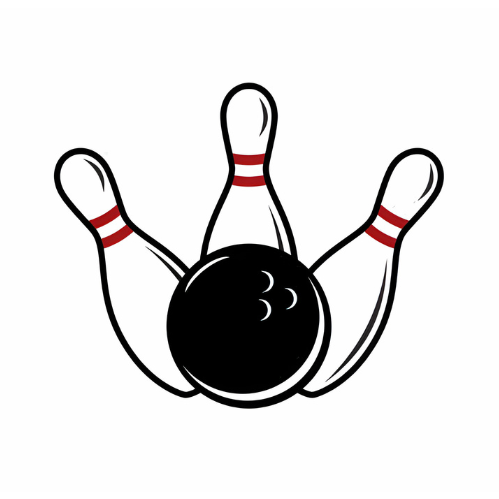If you want to step up in your bowling game, you must learn about your bowling balls. Unless you learn the material and mechanics of the tool you are working with, you cannot accentuate its full potential from it. If you understand the ball’s material and structure, you can predict the ball’s motion, speed, spinning power, etc. and you can get the optimum benefits of a good bowling ball and get your desired results.

Structure of Bowling Balls
Before we get into the different materials for a bowling ball, we need to understand the structure of the balls. Different part of the ball is made with different materials. A suitable material for one part might not be appropriate for the other. In general, bowling balls consist of three layers. The innermost part is known as the core; the outer shell is cover stock, and in between these two layers is filler.
Core Construction: At first a core is formed and then filled with other materials to form a sphere.
Shell making: The spherical core is removed from its mold and placed in a cover stock mold, the core is attached to a pin so that it cannot move. Then more cover stock material is poured over the sphere to seal it.
Gap Filling: When the ball is removed from the cover stock molding, a hole appears where the pin used to be. It is filled with a plastic dowel and then fills the mark
Finishing: The final steps to make the perfect bowling ball are shaving, resurfacing, sanding, and polishing
Details of What Are Bowling Balls Made of
As we have mentioned earlier, a different part of a bowling ball is made with different materials. Here we will discuss them in detail.
1. Core
The core of a bowling ball is the heaviest and innermost part. And its structure massively influences the balance and rotation of the ball. The core comes in various different shapes and sizes. The shapes can be divided into two types, symmetrical and asymmetrical cores. The shape and size vary from ball to ball. Manufacturers try and test different shapes and forms of the core to provide the bowlers with the best core for different bowling styles. Therefore, there is no specific categorization possible for the cores.
However, usually, the core of a bowling ball is made of powdered metal oxides and other catalysts to harden it. For powered metal oxide, it could be calcium oxide or iron oxide, and for hardening catalyst, it could be resin. Most manufacturers or brands do not disclose the exact technology and materials used for their bowling balls for obvious reasons. Therefore, a bowler might have to try several balls to find out the best bowling ball.
2. Cover Stock
Cover stock is the outermost layer or shell of a bowling ball. The majority of a bowling ball’s potential depends on the cover stock material. The cover stock determines which ball is suitable for which style and in what oil condition the ball will work best. There has been vast advancement in terms of cover stock technology. The initial material for the cover stock was too rigid and lacked flexibility. With time and technology, bowling ball cover stock has improved a ton, and it offers more control, precision, and power.
· Wood
Until the 1900s’, bowling balls were used to be made of hardwood. Wooden bowling balls are totally obsolete these days. After 1905, there was not much use of wooden balls in bowling.
· Rubber
In 1905, rubber bowling balls were introduced. Although rubber performed better than wood, it became obsolete in a few years when plastic bowling balls were introduced.
· Plastic
Plastic bowling balls became popular in 1960. Plastic cover stock totally contrasts the previous versions of bowling balls, as they are incredibly lightweight, and other lighter materials for bowling balls are yet to come. In spite of being introduced a long time ago, plastic or polyester cover stocks are still in demand as they are the preferred option for new bowlers. Moreover, they are cheaper than other materials available these days. House balls in bowling alleys are most likely plastic balls. Furthermore, plastic cover stock comes in a plethora of designs. They are shiny, and have a smooth surface, and due to it, they do not absorb oil on the lanes. They create less friction on the lanes and skid through them. Due to these characteristics, they are used for straight bowling style or as a spare ball.
· Urethane
Urethane can be considered the newer and better version of rubber bowling balls, which became popular in the 1980s, and many developments are still being made with this material. Urethane bowling balls are still popular due to many reasons. It originated from polyurethane. They are not as rigid as rubber and create more friction than plastic. Urethane bowling balls have good hooking potential. You can control and predict its motion and rotation and implement different styles. Moreover, with the advancement in bowling lanes, urethane was more suitable for them. By absorbing oils from the lanes, urethane balls could create curves in the backend of the lanes.
· Reactive Resin
With success with urethane, more advancement took place. A modification in urethane was discovered in the early 1990s, and that is reactive resin. It was made by inserting additives to urethane and making the surface more absorbent to oils. This enabled the bowling balls to have more traction and increase hooking potential.
· Reactive Particle-Enhanced
The latest technology and material for the cover stock is particle-enhanced reactive. It was developed in the late 1990s by modifying the previous version. The key specification of this modification is infusing particle elements into the reactive resin cover stock to increase friction. These particles could be anything like rubber, glass, ceramic, etc. Like reactive resin, the cover stock has a lot of pores that absorb oils from the lanes. Above that, the particles would initiate friction while the ball rolls on the lane. Due to these qualities, the hooking potential for these balls skyrocketed. Now, particle-enhanced reactive cover stocks can be divided into three categories.
1. Solid Reactive: These have the most amount of micropores that absorb oils. Therefore, they react the most with oils and can be amazing to play with on heavy oil lanes. These are more suitable for advanced bowlers.
2. Pearl Reactive: Another great option for intermediate to advanced bowlers. These balls have fewer pores than solid reactive balls. The additives used in this ball are more likely to be different minerals. Unlike the previous one, reactive pearl works well on dry lanes.
3. Hybrid Reactive: The hybrid reactive is the in-between of the previous two types. It is like the best of both worlds, as it works well in mid-lane like solid reactive, and performs well in the backend like pearl reactive. This type of cover stock usually contains silica particles as additives.
3. Filler
The in-between part of the core and the cover stock is the filler. Sometimes, it gets dismissed as it can be made of the same materials as the core but lighter. In such cases, the filler is also considered the core. However, the filler consists of other lighter materials such as plastic or glass beads in some other cases. The filler portion mainly depends on the core. If the core takes most of the space, there will not be much filler, and vice versa.
To Conclude
The construction of the bowling ball has evolved throughout all these years, and the progress is still in full flow. With the latest technologies and advancements, new materials, structures, and methods of testing are being introduced to the bowling community. Despite being satisfied with the bowling balls these days, we can surely hope that we might get even better bowling balls in the near future.
